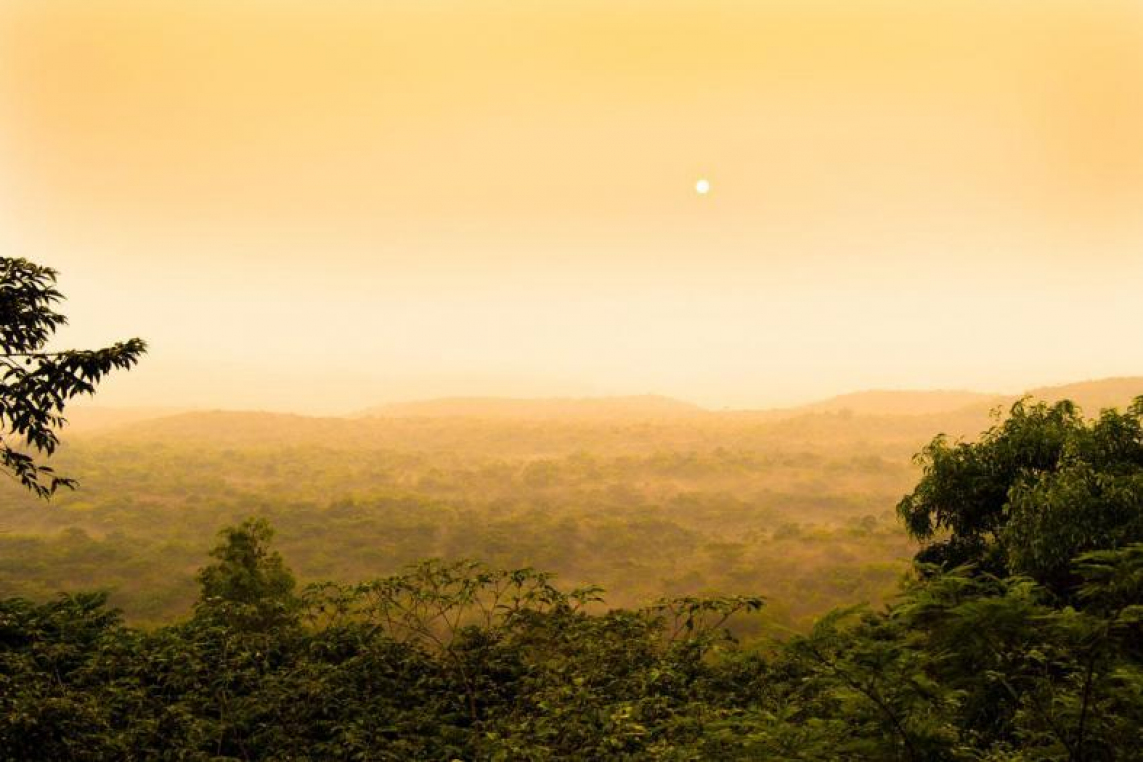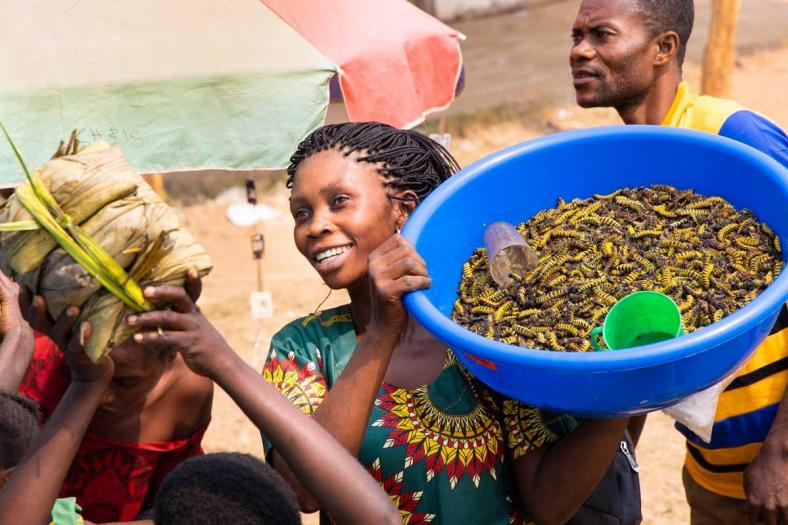John Vandaele bericht over de sociale, ecologische, economische en bestuurlijke aspecten van globalisering.
‘It takes more than one dollar per Congolese to sustain the Central African forest’

The world’s most powerful lung is no longer the Amazon, but the Central African forest basin.
© Bart Lasuy
The world’s most powerful lung is no longer the Amazon, but the Congo forest basin. MO* journalist John Vandaele investigated how many resources the international community is allocating to protect the immense forest. The key question is: can the Congolese boost their prosperity without cutting down their fragile forests? Some conclusions.
Translation of this article is provided by kompreno, using a combination of machine translation and human correction. More articles from MO* are included in kompreno‘s curation of the finest analysis, opinion & reporting — from all across Europe, translated into your language. Original source.
Rich countries that cut down their forests long ago seem increasingly aware that they will have to make more efforts to convince other countries not to do the same. For example, the European Union recently issued a directive banning products that were created from deforestation. Then again, at the UN nature summit in Canada, it was agreed that some USD 30 billion will be freed up annually to protect biodiversity from 2030 onwards.
Whoever speaks of biodiversity immediately thinks of rainforests. These are real hotspots of biodiversity. They are also the lungs of the world because they absorb a lot of CO2 from the air.
We have every interest in preserving the Central African forest.
The world’s most powerful lung is no longer the Amazon, but the Central African forest basin. Research, including the one carried out by UGent scientists, shows that between 2010 and 2020, the basin accounted for an annual uptake of 0.37 gigatonnes of CO2, against 0.25 gigatonnes for the Amazon.
The reason is that CO2 uptake per hectare has remained almost constant in Africa over the past 30 years (a drop from 670 to 630 kilograms), while in the Amazon it has dropped from 530 kilograms to 230 kilograms per hectare. Many more trees die in the Amazon forest because it is warmer and drier. As a result, Africa has become more important than the Amazon as a carbon sink.
If you add to that the carbon storage in the trees and swampy substrates, the loss of the Central African forest would amount to 10 times the global CO2 emissions (35 billion gigatonnes). Therefore, we have every interest in preserving that forest.
Yet more than 1% of it is lost every year. If it continues, it will be gone by the end of this century. The new EU directive will do little to help that, because — unlike the Amazon — deforestation in Central Africa is the result of the population’s way of life.

Unlike in the Amazon, deforestation in Central Africa is the result of the lifestyle of the population.
© Bart Lasuy
Forest-dependent
As much as 70% of the Central African forest lies in the Democratic Republic of Congo (DRC). Today, the huge country is home to some 90 million people. By 2050, the United Nations expects 200 million Congolese, and 400 million by the end of this century. Congo therefore has one of the fastest-growing populations in the world.
And that population needs the forest. Throughout the region, residents use makala, charcoal in the local language, for cooking and heating. A growing charcoal industry has sprung up around every town in recent decades.
The forest is also their pharmacy, the source of building materials and of protein.
But the forest is also the main source of fertile farmland. For centuries, farmers have been practising so-called nomadic agriculture there. This involves cutting down a piece of the forest, letting it dry and setting it on fire. The ashes are then used as fertiliser.
For centuries, this was a fairly rational approach to obtaining fertile farmland. As long as there were only 10 million Congolese, farmers only returned to the same place 30 years later, allowing the forest to recover. Now, roaming agriculture increasingly amounts to deforestation.
Finally, for this population, the forest is also their pharmacy, the source of building materials and of protein (caterpillars and game, which again threatens various species).

The forest is also the pharmacy, the source of building materials and of proteins.
© Bart Lasuy
Fast-growing trees
So, the population’s pressure on the rainforest is great. If the Congolese are not to do what most peoples on earth have already done in the meantime — cut down their natural forests — the global community will have to help them realise prosperity without cutting down their forest.
That will cost money. The world is gradually becoming aware of this. For MO*, I researched how much money is going into it. Over the past five years, effective spending amounted to about $100 million annually — one dollar per Congolese. The lion’s share of that came from the Central African Forest Initiative (CAFI) to which Belgium, but especially Norway, also contributes.
There are also private flows of money coming to Congo to reforest, or protect forests. These may be aimed at offsetting their own carbon emissions, or simply at fighting climate change, as well as for local development.
Farmers working on their plantations have less time to migrate to the forest.
It is difficult to precisely map their size, but experts tell me they are smaller than public financial flows for now. That would mean that for forest protection and reforestation, less than two dollars per Congolese comes to the country.
I also checked what happens to those funds. Some $40 million, much of it from the EU and Germany, goes to managing nature parks, some of which are larger than Belgium. The rest goes to large provincial projects that fight deforestation in many ways.
I visited the project in Mai-Ndombe province (four times the size of Belgium). There was $40 million to spend. My impression is that those funds are, to a large extent, actually spent on the ground.
The most successful part of the project involves plantations of fast-growing trees in savannah areas. These allow charcoal to be produced after seven years, which reduces pressure on the forest and can provide income for the farmers planting the trees. The project also seeks to enrich existing agriculture with new crops, such as cocoa, or improved palm trees or cassava varieties.
This should increase farmers’ income by using existing farmland more intensively. Farmers working on their plantations have less time to migrate to the forest. Villages in forest zones will also be compensated to protect part of their forest.
This is still at an early stage. I visited one such protected stretch of forest and saw that the boundary posts had ‘fallen over.’ So, there is still room for improvement in the practical implementation of the project. In each of these activities, people are paid to participate, which immediately provides additional income. This is very important to create public support.

The population’s pressure on the Congolese forest is substantial.
© Bart Lasuy
Concluding observations
What lessons can we draw from the study?
One. Resources hit the ground running to a significant extent. This is because the money is managed by structures in which Congolese and international organisations sit together.
Two. These are no more than interesting first steps. This involves long-term work, but there is fear that, as usually happens, donors will look for new project enablers after a few years. That would be a pity. If the world’s most important lung is to last, the Congolese and international organisations will have to work together for a long time.
Three. More money will also be needed. Do we really think that one dollar per Congolese will be enough to motivate them not to do what just about all peoples have been doing to them: cut down their natural forests?
Nothing will really work — that is, the forest will not survive — if it does not benefit the population.
The Congolese government itself sees things in much bigger terms. It submitted to the climate convention in 2021 a contribution that would cost $41 billion. That, however, seems like an exaggeration. A middle ground must be found for Congo to become ‘le pays solution’ (‘the solution country’) that it claims it wants to be.
Four. It remains to be seen how big the private financial flows will be in the future. Can the drive to offset their own emissions among numerous companies ensure that the forest is preserved? This can only happen if it is meticulously established that deforestation has been effectively avoided, or that new forest has been planted.
That requires strong standards, procedures and monitoring bodies. That is what public agencies must help ensure. Nothing will really work — that is, the forest will not survive — if it does not benefit the population. Granting carbon credits without that social condition being met is short-sighted.
Building a support base for reforestation is possible: we found that the Belgian reforestation project Faja Lobi is very popular with the population because it provides people with jobs — but only as long as it continues to do so. Therefore, it remains a challenge. Colruyt Group, which wants to offset its emissions by planting forest in Congo, is still at the beginning of that quest.
Five. The more general question is whether the forest, its protection, and reforestation can ensure more prosperity in Congo. In other words: can the country find an ecological development path that combines prosperity with the preservation of its mighty forest? The coming decades will have to prove that.

Do we really think that one dollar per Congolese will suffice to motivate them not to do what just about all peoples suggested they do: cut down their natural forests?
© Bart Lasuy
 This reportage was produced with the support of the Pascal Decroos Fund for Special Journalism.
This reportage was produced with the support of the Pascal Decroos Fund for Special Journalism.
Maak MO* mee mogelijk.
Word proMO* net als 2798 andere lezers en maak MO* mee mogelijk. Zo blijven al onze verhalen gratis online beschikbaar voor iédereen.
Meer verhalen
-
Report
-
Report
-
Report
-
Interview
-
Analysis
-
Report










 Oxfam België
Oxfam België Handicap International
Handicap International